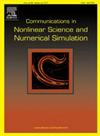Convergence and superconvergence analysis for a mass conservative, energy stable and linearized BDF2 scheme of the Poisson–Nernst–Planck equations
IF 3.8
2区 数学
Q1 MATHEMATICS, APPLIED
Communications in Nonlinear Science and Numerical Simulation
Pub Date : 2024-09-17
DOI:10.1016/j.cnsns.2024.108351
引用次数: 0
Abstract
In this paper, we consider a linearized BDF2 finite element scheme for the Poisson–Nernst–Planck (PNP) equations. By employing a novel approach, we rigorously derive unconditional optimal error estimates of the numerical solutions in the and norms, as well as superconvergent results. The key of the convergence and superconvergence analysis lies in deriving the stability of the finite element solutions in some stronger norms. The advantage of this approach is that there is no need to introduce a corresponding time discrete system, so it is more concise than the error split technique in previous literatures. Finally, we carry out two numerical examples to confirm the theoretical findings.
泊松-纳斯特-普朗克方程的质量保守、能量稳定和线性化 BDF2 方案的收敛性和超收敛性分析
在本文中,我们考虑了泊松-恩斯特-普朗克(PNP)方程的线性化 BDF2 有限元方案。通过采用一种新方法,我们严格推导出数值解在 l∞(L2) 和 l∞(H1) 规范下的无条件最优误差估计以及超收敛结果。收敛和超收敛分析的关键在于推导出有限元解在某些更强规范下的稳定性。这种方法的优点是无需引入相应的时间离散系统,因此比以往文献中的误差分割技术更为简洁。最后,我们通过两个数值实例来证实理论结论。
本文章由计算机程序翻译,如有差异,请以英文原文为准。
求助全文
约1分钟内获得全文
求助全文
来源期刊

Communications in Nonlinear Science and Numerical Simulation
MATHEMATICS, APPLIED-MATHEMATICS, INTERDISCIPLINARY APPLICATIONS
CiteScore
6.80
自引率
7.70%
发文量
378
审稿时长
78 days
期刊介绍:
The journal publishes original research findings on experimental observation, mathematical modeling, theoretical analysis and numerical simulation, for more accurate description, better prediction or novel application, of nonlinear phenomena in science and engineering. It offers a venue for researchers to make rapid exchange of ideas and techniques in nonlinear science and complexity.
The submission of manuscripts with cross-disciplinary approaches in nonlinear science and complexity is particularly encouraged.
Topics of interest:
Nonlinear differential or delay equations, Lie group analysis and asymptotic methods, Discontinuous systems, Fractals, Fractional calculus and dynamics, Nonlinear effects in quantum mechanics, Nonlinear stochastic processes, Experimental nonlinear science, Time-series and signal analysis, Computational methods and simulations in nonlinear science and engineering, Control of dynamical systems, Synchronization, Lyapunov analysis, High-dimensional chaos and turbulence, Chaos in Hamiltonian systems, Integrable systems and solitons, Collective behavior in many-body systems, Biological physics and networks, Nonlinear mechanical systems, Complex systems and complexity.
No length limitation for contributions is set, but only concisely written manuscripts are published. Brief papers are published on the basis of Rapid Communications. Discussions of previously published papers are welcome.
 求助内容:
求助内容: 应助结果提醒方式:
应助结果提醒方式:


